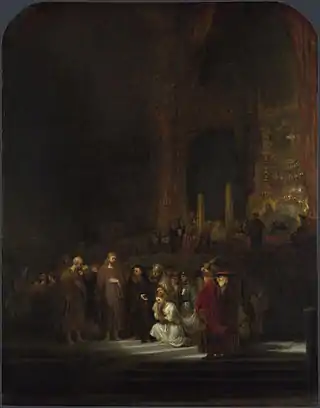Johannes de Renialme
Johannes de Renialme (Antwerp, ca. 1600 – buried Amsterdam, 20 April 1657) was a Dutch art dealer, active in Amsterdam and Delft between 1640 and 1657, notable for the scale of his dealings. De Renialme was known for being a dealer of Rembrandt, Hercules Seghers, Jan Lievens and Salomon Koninck. Among his clients was Frederick William, Elector of Brandenburg.[1]
Johannes de Renialme | |
|---|---|
| Born | about 1600 Antwerp |
| Died | 20 April 1657 Amsterdam |
| Nationality | Dutch |
| Occupation | art dealer |
| Spouse(s) |
|
Biography
Johannes de Renialme was born in Antwerp around 1600. He came from a distinguished family of Antwerp and Venice. From the early 1620s until at least 1637 he was living in Middelburg. There is no evidence that he had any training in art, but was known to have practiced as goldsmith and jeweller; he also traded in jewellery.[1]
De Renialme was married four times. On 9 April 1629, he married Margrita Bertolotti van den Heuvel, who died in 1630. He next married Maria de Cocquel and from her inherited some property in Ireland.[1]

On 19 August 1639, he married Maria Weinrich, widow of the Delft beer brewer Nicolaes Tristram. On 12 August 1640 they had their son Joannes baptised in the Nieuwe Kerk in Amsterdam.[2]
De Renialme's last wife was Catharina d'Overdage whom he married on 1 January 1643 in Delft. When he died in 1657, he was survived by Catharina and his son Joannes. De Renialme was buried on 20 April 1657 in a Dutch Reformed Church ceremony.[2]
Dealership in art
The first evidence of his purchases of art is from records of the Johan van Maerlen (1577-1637) sale of 30 September 1637 in which he was a buyer.[1][3]

By 25 April 1640, his inventory listed 149 art works, among which paintings by Hercules Seghers, Jan Miense Molenaer, Hendrick ter Brugghen, Albrecht Dürer and a Rembrandt, valued highest of all at 100 Dutch guilders.[4][5]
In order to sell there, he joined Delft's Guild of St. Luke in 1644, maintaining houses in Delft and Amsterdam.[2]
Upon his death his inventory of 538 artworks was valued at 36,512 guilders.[2] There were 13 paintings by Rembrandt.[1]
References
- Montias, John Michael (2002). Art at Auction in Seventeenth-century Amsterdam. Amsterdam University Press. ISBN 9789053565919.
- The Frick Collection. "Inventory # 180". The Frick Collection. Archived from the original on 25 September 2013. Retrieved 22 July 2013.
- The Frick Collection. "Inventory # 270". The Frick Collection. Retrieved 21 July 2013.
- The Frick Collection. "Inventory # 1040". The Frick Collection. Retrieved 22 July 2013.
- Bredius, Abraham (1915). Künstler-Inventare: Urkunden zur Geschichte der holländischen Kunst des 16ten, 17ten und 18ten Jahrhunderts (in German). M. Nijhoff. pp. 229–239. Retrieved 22 July 2013.